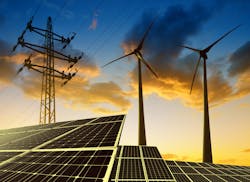2. Minimization of catastrophic downtime during weather events
In 2020, more than 120 million utility customers were impacted by power outages. That number is no fluke. Outages are on the rise. The current five-year average of weather events is double versus the 1980-2021 average. What’s causing so many outages? Utility companies, like Advanced Energy, are reporting the majority of their outages as a result of weather events. In 2021, there were 20 natural disasters in the US — including two floods, 11 severe storms, four hurricanes, one wildfire and one winter storm — all of which resulted in power outages. With natural disasters on the rise, it means your grid is not infallible. It’s only a matter of time before you experience an outage that has corresponding national media coverage and scrutiny. But you can be prepared and help keep essential manufacturing and services operating with decentralized microgrid solutions powered by natural gas generators.
3. Peak shaving savings
Over $710 million was awarded to commercial and industrial businesses in 2020 for their participation in demand response programs. However, that $710 million does not all come at a cost to the local utilities. By removing their customers’ power demands and/or adding their generated power back to the grid, utilities can peak shave, avoid rate volatility and offset the costs of their demand response programs.
4. Greater overall utility system reliability
Having backup power from microgrids provides resilient power, resulting in a more resilient solution for the utility. When you provide a more resilient solution, it improves your overall utility system reliability. That means you’re able to report better annual system reliability to regulatory authorities. The national System Average Interruption Duration Index (SAIDI) with MED (major event days) minus LOS (loss of supply) was 394 and the System Average Interruption Frequency Index (SAIFI) with MED minus LOS was 1.5 days. With sponsored programs that provide on-site generation to customers, you can let the resultant “non-outages” be considered in your index calculations, and, over time, significantly move the needle on those performance metrics and outperform national averages.
5. Avoidance of large capital expenditures
Just like demand response programs, sponsored power generation can improve the utility’s system generation capacity status and help you avoid upgrading substations and transmission or distribution systems.
For example, suppose a long, heavily loaded distribution circuit has a low voltage problem. Traditionally, the solution to such a problem would be the addition of voltage regulators somewhere on the circuit or the complete reconductoring of a significant length of the circuit. Instead, placing distributed generation along the circuit, via a sponsored microgrid, can provide the needed voltage boost and thus delay or avoid a large capital expense. Utilities can also dispatch the distributed generators to solve other problems such as low frequency or poor power factor.
In conclusion, when the utility provides edge resiliency through decentralized microgrids, it helps both the consumer and the utility — making it an endeavor worth pursuing for all parties. Instituting decentralized microgrids has never been easier because of turnkey power generation companies like Mesa Solutions. By leveraging third-party power generation companies, microgrids can be executed seamlessly and quickly for both the utility and consumer. On-staff engineers work directly with customers to design and install microgrids and customize generators for their application needs. Local technicians service and maintain the equipment, and demand response experts ensure their company is working within established parameters. Even though microgrid resources are somewhat novel to utility design, utilities can take advantage of the same turnkey sourcing, support and financing that is available to customer-driven microgrid projects — making the benefits of microgrids available and easier for all.
Tom Poteet is vice president of corporate development at Mesa Solutions.








